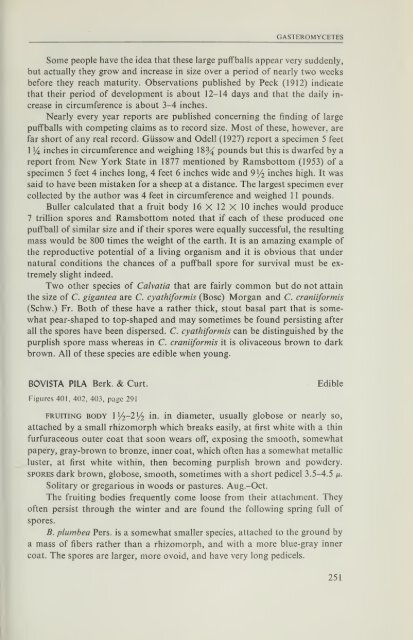You also want an ePaper? Increase the reach of your titles
YUMPU automatically turns print PDFs into web optimized ePapers that Google loves.
GASTEROMYCETES<br />
Some people have the idea that these large puffballs appear very suddenly,<br />
but actually they grow and increase in size over a period of nearly two weeks<br />
before they reach maturity. Observations published by Peck (1912) indicate<br />
that their period of development is about 12-14 days and that the daily in-<br />
crease in circumference is about 3-4 inches.<br />
Nearly every year reports are published concerning the finding of large<br />
puffballs with competing claims as to record size. Most of these, however, are<br />
far short of any real record. Giissow and Odell (1927) report a specimen 5 feet<br />
1 54 inches in circumference and weighing 18J^ pounds but this is dwarfed by a<br />
report from New York State in 1877 mentioned by Ramsbottom (1953) of a<br />
specimen 5 feet 4 inches long, 4 feet 6 inches wide and 9)/2 inches high. It was<br />
said to have been mistaken for a sheep at a distance. The largest specimen ever<br />
collected by the author was 4 feet in circumference and weighed 1 1 pounds.<br />
BuUer calculated that a fruit body 16 X 12 X 10 inches would produce<br />
7 trillion spores and Ramsbottom noted that if each of these produced one<br />
puffball of similar size and if their spores were equally successful, the resulting<br />
mass would be 800 times the weight of the earth. It is an amazing example of<br />
the reproductive potential of a Hving organism and it is obvious that under<br />
natural conditions the chances of a puffball spore for survival must be ex-<br />
tremely shght indeed.<br />
Two other species of Cahatia that are fairly common but do not attain<br />
the size of C. gigantea are C cyathiformis (Bosc) Morgan and C. craniiformis<br />
(Schw.) Fr. Both of these have a rather thick, stout basal part that is somewhat<br />
pear-shaped to top-shaped and may sometimes be found persisting after<br />
all the spores have been dispersed. C cyathiformis can be distinguished by the<br />
purplish spore mass whereas in C. craniiformis it is olivaceous brown to dark<br />
brown. All of these species are edible when young.<br />
BOVISTA PILA Berk. & Curt. Edible<br />
Figures 401, 402, 403, page 291<br />
FRUITING BODY 1 1/2-2 Yi in. in diameter, usually globose or nearly so,<br />
attached by a small rhizomorph which breaks easily, at first white with a thin<br />
furfuraceous outer coat that soon wears off, exposing the smooth, somewhat<br />
papery, gray-brown to bronze, inner coat, which often has a somewhat metaUic<br />
luster, at first white within, then becoming purplish brown and powdery.<br />
SPORES dark brown, globose, smooth, sometimes with a short pedicel 3.5-4.5 /x.<br />
Solitary or gregarious in woods or pastures. Aug.-Oct.<br />
The fruiting bodies frequently come loose from their attachment. They<br />
often persist through the winter and are found the following spring full of<br />
spores.<br />
B. plumbea Pers. is a somewhat smaller species, attached to the ground by<br />
a mass of fibers rather than a rhizomorph, and with a more blue-gray inner<br />
coat. The spores are larger, more ovoid, and have very long pedicels.<br />
251

















